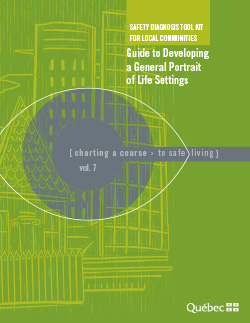Safety Diagnosis Tool Kit for Local Communities: Guide to Developing a General Portrait of Life Settings
To do a safety diagnosis for a particular life setting, you have to get to know the setting. You will thus obtain a good understanding of its specific characteristics, as well a frame of reference for data collection activities. The present guide describes the main steps involved in developing a life setting’s general portrait.
Although many parameters can be used to characterize a life setting, some warrant special attention in a process aimed at improving safety or preventing crime; for example, the setting’s geographic, human and economic characteristics and some of its physical characteristics pertaining to housing. Gaining insight into these characteristics will enable you to:
- share in general knowledge about the life setting under study;
- clearly define the setting in relation to the surrounding area and according to zones of interest;
- ensure that all segments of the population are well represented;
- frame requests for information more precisely so as to obtain the data you need to make a safety diagnosis;
- obtain a better understanding of the specific characteristics of the life setting in relation to those of other settings;
- identify characteristics that will make it possible to determine the social and physical conditions likely to affect the safety of the life setting;
- craft a message that is tailored to the different segments of the population.
It is thus essential to develop a general portrait of the life setting under study at the beginning of the diagnostic process. Developing this type of portrait can be fairly complex depending on the size of the setting, the availability of information, the different groups represented in the population, the range of economic activities and so forth. Nonetheless, you must strive to avoid complicating the process, insofar as possible, and ensure that the information gathered will really be useful for the diagnosis. The procedure involves six steps:
- plan the general portrait;
- process and analyze the information on the setting's geographic characteristics;
- process and analyze the information on the setting’s population characteristics;
- process and analyze the information on the setting's economic characteristics;
- process and analyze the information on the characteristics pertaining to housing;
- identify key findings on the setting's characteristics.
The present guide is organized around these steps. In addition, to more fully explain the proposed procedure, the guide presents an example of its application in a fictitious regional county municipality (RCM) known as “Les Plateaux”. However, for easier understanding, the amount of information processed is more limited than in a real-life situation and the analysis of the information has been somewhat simplified.


